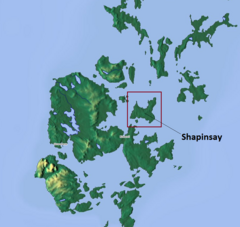Shapinsay
| Shapinsay | |
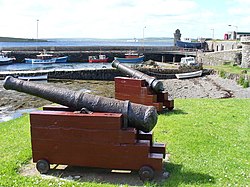 Shapinsay Harbour | |
|---|---|
| Main town: | Balfour |
| Location | |
| Grid reference: | HY505179 |
| Area: | 11 square miles |
| Highest point: | Ward Hill, 210 feet |
| Data | |
| Population: | 300 |
Shapinsay is one of the islands of Orkney. It has but one village, Balfour, from which roll-on/roll-off car ferries sail to Kirkwall on the Orkney Mainland.
Balfour Castle, built in the Scottish Baronial style, is one of the island's most prominent features, a reminder of the Balfour family's domination of Shapinsay during the 18th and 19th centuries; the Balfours transformed life on the island by introducing new agricultural techniques. Other landmarks include a standing stone, an Iron Age broch, a souterrain and a salt-water shower.
With an area of 7,285 acres, Shapinsay is the eighth largest island in Orkney. It is low-lying and fertile, consequently most of the area is given over to farming.
Shapinsay has two nature reserves and is notable for its bird life.
As of the 2001 census, Shapinsay has a population of 300. The economy of the island is primarily based on agriculture with the exception of a few small businesses that are largely tourism-related. Plans for the construction of a wind turbine are under consideration.
Name of the island
Unlike most of the larger Orkney islands, the derivation of the name 'Shapinsay' is unknown. The final 'ay' is from the Old Norse for island, but the first two syllables are more difficult to interpret. Haswell-Smith (2004) suggests the root may be hjalpandis-øy (helpful island) owing to the presence of a good harbour, although anchorages are plentiful in the archipelago.[1] The first written record dates from 1375 in a reference to Scalpandisay, which may suggest a derivation from Judge's island.[2]
History
Early history
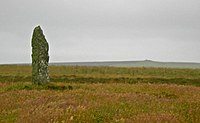
Standing stones provide evidence of the island's human occupation since Neolithic times. Local legend holds that the Roman general Gnaeus Julius Agricola landed on Shapinsay when taking the submission of the islands, though there is no true evidence. During the 18th century, a croft named Grukalty was renamed Agricola (which is also Latin for "farmer"). Roman coins have been found on Shapinsay, but they may have been brought to the island by traders.[3][4]
Shapinsay is briefly mentioned in the Norse sagas]]. The Saga of Haakon Haakonsson states that Haakon IV of Norway anchored in Elwick Bay before sailing south to eventual defeat at the Battle of Largs.[1]
18th century
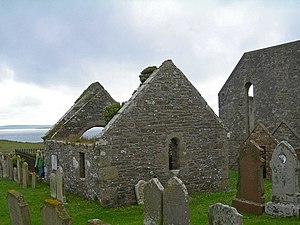
The 18th century saw the coming of the Agricultural Revolution to Shapinsay, in techniques introduced by the Balfour family. The family owned the estate of Sound, which covered the western part of the island.
Sound had passed from the Tulloch family to the Buchanan family in the 17th century. In 1674, Arthur Buchanan built the house of Sound, where Balfour Castle now stands. His granddaughter married James Fea, who is best known for his role in the capture of the Orkney Pirate John Gow. Fea was a supporter of the Jacobite Rebellion, and the house was burned by the King's soldiers in revenge. The estate was acquired by Andrew Ross, Stewart Depute in Orkney of the Earl of Morton. Ross's heirs, the Lindsay brothers, sold the estate to Thomas Balfour in 1782.[3][4]
Thomas Balfour had previously rented the Bu of Burray, a large manor farm on another Orkney island, but had insufficient wealth to acquire the estate even though his wife had inherited a legacy on the death of her aristocratic brother. To raise the necessary funds, Balfour had to sell his military commission and borrow from his brother, John, who was prospering in India with the East India Company.[4] Once installed on the island, he built a new house, Cliffdale, and founded the village of Shoreside, now known as Balfour. He also reformed the local agriculture, enclosing fields and constructing farm buildings.
William Irving was born c. 1740 in the small hamlet of Quholm in the northeast of the island. He became a sailor before emigrating to New York in 1763. One of his sons was Washington Irving, author of Rip van Winkle and the first American author to gain international recognition.[3]
Marjory Meason, a native of Shapinsay, was the last person to be executed in Orkney, in 1728. She was a young servant, hanged in Kirkwall for the murder of a child. The execution is recorded as requiring 24 armed men, not including officers, and costing £15 8s.[3]
During this period, burning kelp was a mainstay of the island economy. More than 3050 tons of burned seaweed were produced each year to make soda ash, bringing in £20,000 for the inhabitants.[1] Thomas Balfour's income from the kelp industry brought him four times the income that farming did.[4]
19th century
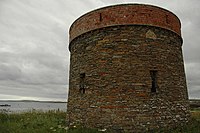
The 19th century saw more radical change in Shapinsay. Thomas Balfour's grandson, David Balfour, transformed the island after inheriting the family estate, which by 1846 encompassed the whole of Shapinsay. Most of the land was divided into fields of 10 acres,[5] a feature that is still apparent today. Tenants were required to enclose and drain the land or pay for the estate to do it in the form of a surcharge added to their rents. In 1846, 749 acres on Shapinsay consisted of arable land. By 1860, that had trebled.[5] New crops and breeds of cattle and sheep were also introduced.[3] Balfour's reforms were described as "the fountain and source of Orkney Improvement."[4]
Balfour also gave the island its most noticeable landmark when he recruited an Edinburgh architect, David Bryce, to transform Cliffdale House into the Scottish Baronial Balfour Castle.[6]
Other buildings he added to the island include the porter's lodge (now a public house called The Gatehouse), a water mill, a school, and a gasworks that remained operational until the 1920s.[3][7] The gasworks is in the form of a round tower with a corbelled parapet of red brick and carved stones—including one possibly removed from Noltland Castle on Westray, which is inscribed with the year 1725. The structure appears to be fortified, in accordance with Balfour's intention to give the village a mediæval appearance.[4][8] David Balfour was also responsible for the construction of Mill Dam, a wetland which was once the water supply for the mill and is now an RSPB nature reserve.[3]
Fishing for herring and cod also grew in importance during the 19th century. Herring fishing was expanding generally in the north at that time, with fishing stations being set up in remote areas. Herring fishing began in 1814 on Stronsay and soon spread throughout the Orkney Islands.[4] By the middle of the century, Shapinsay had 50 herring boats.[9] Cod became important largely because the Napoleonic Wars forced English fishing boats to fish further north. Local fishermen, who had been catching fish using lines from small boats for centuries, also began trawling for cod. However, this was largely a part-time venture, unlike in Shetland, where many inhabitants made a living from fishing. A saying originating from this time states, "a Shetlander is a fisherman with a croft, while an Orcadian is a farmer with a boat." Consequently, fishermen from outside the Orkney Islands earned a large share of the profits. Helliar Holm's beaches were used to dry both herring and cod after they had been salted.[4] With the end of the Napoleonic Wars, which led to cheaper sources of soda ash becoming available from continental Europe, the kelp industry collapsed by 1830.[3][10] This collapse helped fuel agricultural reform, as crofters accustomed to earning a second income had to now earn more from farming.[4]
20th century
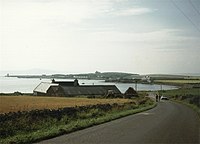
The Balfour estate sold its farms on Shapinsay between 1924 and 1928. This was a common occurrence in Orkney at the time as wealthy landowners moved to more lucrative forms of investment. Farms were generally sold to the sitting tenant or to their neighbours who wished to expand.[4]
The 20th century saw many changes in farming on Shapinsay. Mechanised implements came to the island, particularly after the Second World War. In common with the rest of Orkney, the amount of land given over to growing grass increased. The growing of grain (with the exception of barley) and turnips steadily declined as these were replaced as winter fodder for livestock by silage, usually harvested by mechanical forage harvesters.[11]
Orkney was a strategic site during both World Wars, and Shapinsay was no exception. In 1917, during the First World War, the Swiftsure was hit by a mine 2½ miles east of Haco's Ness and sank in 62 feet of water with the loss of a single life. The site of the wreck was not discovered until 1997.[12]
During the Second World War, gun batteries were built on the island. A twin six-pounder emplacement at Galtness Battery on the coast at Salt Ness protected the Wide Firth from German torpedo boats. A Castle Battery was operational from 1941–43, as was an anti-aircraft battery.[3] Mains electricity arrived on Shapinsay in the 1970s, when an underwater cable was laid from Kirkwall.
Tourism started to become important in the latter half of the century; the first restaurant to incorporate bed and breakfast facilities opened in 1980.
Geography
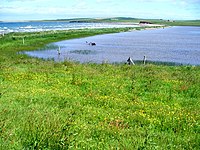
Shapinsay is the 8th largest Orkney island. The highest point of Ward Hill is 210 feet above sea level.[1] The east coast is composed of low cliffs and has several sea caves, including the picturesque geo at the extreme northern tip known as Geo of Ork.[3] Elwick Bay is a sheltered anchorage on the south coast, facing the Orkney mainland; the island's largest settlement, Balfour, is at the western end of the bay.
The island has several ayres, or storm beaches, which form narrow spits of shingle or sand cutting across the landward and seaward ends of shallow bays. They can sometimes cut off a body of water from the sea, forming shallow freshwater lochs known as oyces.[13] Examples include Vasa Loch and Lairo Water.[14]
There are several small islands in the vicinity including Broad Shoal, Grass Holm and Skerry of Vasa. Helliar Holm is a tidal islet at the eastern entrance to the main harbour at Balfour; it has a small lighthouse and a ruined broch. The String, a stretch of water that lies between Helliar Holm and the mainland, has strong tidal currents.[1]
Flora and fauna
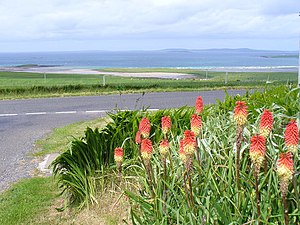
The island's bird life is particularly rich in waders such as curlew and redshank, found at The Ouse and Veantro Bay, and gull and tern colonies on the rockier shores and cliffs. Pintail, shovellers and whooper swans are regular summer visitors, and there are also breeding populations of shelducks, hen harriers and bonxies.[15] There is an introduced population of red-legged partridges.[16] Otters can be seen at the Ouse, Lairo Water and Vasa Loch, and at various places around the coast along with common seals and Atlantic grey seals. There are plans to build a hide to allow visitors to observe seals without disturbing them.[3] Shapinsay and Hoy are the only two larger Orkney islands that lack the Orkney vole (Microtus arvalis orcadensis).[17] Wildflowers abound in the summer, and the lichen Melaspilea interjecta, which is endemic to the north, is found in only three locations, including Shapinsay.[18][19] In addition to the RSPB reserve at Mill Dam there is a Scottish Wildlife Trust reserve at East Hill in the southeast.
Notable buildings
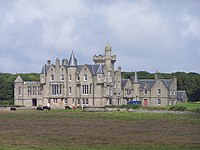
Balfour Castle dominates views of the southwest of the island and can be seen from the tower of St Magnus Cathedral in Kirkwall. The castle library has a secret passage hidden behind a false set of bookshelves. The Balfours escaped unwelcome visitors through this passageway, which leads to the conservatory door, enabling the butler to tell visitors truthfully that the Balfours were not in the house. Another feature of the castle is the stags' heads with gaslights at the tips of their antlers, although these are no longer used as working lights. The castle grounds feature deciduous woodland (now rare in Orkney) and 2 acres of walled gardens.[6]
Other buildings constructed by David Balfour include the Dishan Tower, known locally as The Douche. This is a saltwater shower building with a dovecote on top. A local landmark due to its high visibility when approaching the island by sea, the building is now in a serious state of disrepair, with roofing slates missing and the dovecote in danger of collapsing.
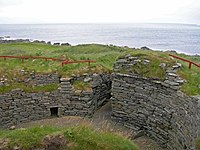
A more ancient dwelling on Shapinsay is the Iron Age Broch of Burroughston. Only the interior of this partially buried building has been excavated, allowing visitors to look down into the broch from the surrounding mound. The surviving dry stone walls rise to about 10 feet and are more than 13 feet thick in some places.[20]
The broch shows more evidence of David Balfour's influence on Shapinsay. He arranged for the site to be excavated by the archaeologists George Petrie and Sir William Dryden in 1861.[21] The site was neglected after the excavation, slowly filling up with vegetation and rubble before being cleared in 1994.[22]
Shapinsay Heritage Centre is located in Balfour's former smithy, along with a craft shop and a cafe. The castle's former gatehouse is now the village public house.[18]
Folklore
Cubbie Roo, the best known Orcadian giant, has a presence on Shapinsay. He was originally based on the historical figure Kolbein Hrúga, who built Cubbie Roo's Castle in 1150 on the isle of Wyre, which is possibly the oldest castle in Scotland, and was mentioned in the Orkneyinga Saga.[1] However, the figure Cubbie Roo has departed far from his historical origins and has become a giant in the fashion that Finn MacCool (legendary builder of the Giant's Causeway) has in Ireland. He is said to have lived on the island of Wyre and used Orkney's islands as stepping stones. Many large stones on Orkney islands, including Shapinsay, are said to have been thrown or left there by the giant. Cubbie Roo's Burn is a waterway on Shapinsay that flows through a channel called Trolldgeo. Cubbie Roo's Lade is a pile of stones on the shore near Rothiesholm Head, the westmost point of Stronsay. This is supposedly the beginning of a bridge between the two islands that the giant had failed to complete. The name derives from the Old Norse trolla-hlad, meaning "giant's causeway".[23]
References
- ↑ 1.0 1.1 1.2 1.3 1.4 1.5 Haswell-Smith (2004) op cit pages 364–7.
- ↑ "Orkney Placenames" Orkneyjar. Retrieved 10 October 2007.
- ↑ 3.00 3.01 3.02 3.03 3.04 3.05 3.06 3.07 3.08 3.09 3.10 Tait, Charles (2006) op cit pages 498–507
- ↑ 4.00 4.01 4.02 4.03 4.04 4.05 4.06 4.07 4.08 4.09 Thomson, William P.L (2001). The New History of Orkney. Edinburgh: Mercat Press. ISBN 978-1841830223.
- ↑ 5.0 5.1 Thomson, William P.L. "Agricultural Improvement" in Omand, Donald (ed.) (2003) op cit page 98.
- ↑ 6.0 6.1 "Balfour Castle Feature Page". Undiscovered Scotland. http://www.undiscoveredscotland.co.uk/shapinsay/balfourcastle/index.html. Retrieved 13 August 2007.
- ↑ "Balfour Feature Page". Undiscovered Scotland. http://www.undiscoveredscotland.co.uk/shapinsay/balfour/index.html. Retrieved 13 August 2007.
- ↑ Wickham-Jones, Caroline (2007) Orkney: A Historical Guide. Edinburgh. Birlinn. Page 193.
- ↑ Fenton, Alexander (1997). The Northern Isles. East Linton: John Donald.
- ↑ "Shapinsay Feature Page". Undiscovered Scotland. http://www.undiscoveredscotland.co.uk/shapinsay/shapinsay/. Retrieved 13 October 2007.
- ↑ 116,664 acres of farmland (90% of the archipelago's cultivated land excluding rough grazing) is now under grass, of which 40,668 acres are cut for hay or silage. Thomson, William P.L (2001) op cit page 422.
- ↑ "North Isles and beyond Wreck Database" Scapa Flow Charters. Retrieved 13 October 2007
- ↑ "Voes, Ayres and Beaches" Scottish Natural Heritage. Retrieved 12 October 2007.
- ↑ "Shapinsay". VisitOrkney. http://www.visitorkney.com/orkney_isles/shapinsay.asp. Retrieved 12 October 2007.
- ↑ "Mill Dam, Shapinsay: Star Species" RSPB. Retrieved 12 October 2007.
- ↑ "RSPB Bird Reports" Visitorkney.com. Retrieved 12 October 2007.
- ↑ Tofts, Russell "The Orkney Vole" National Association of Private Animal Keepers. Retrieved 12 October 2007.
- ↑ 18.0 18.1 "Shapinsay" orkney.org. Retrieved 12 October 2007.
- ↑ "Lichens Species Action Plan" (pdf) Stirling Council. Retrieved 13 October 2007
- ↑ Hogan, C. Michael (7 October 2007). Burroughston Broch. The Megalithic Portal. ed Andy Burnham. Retrieved on 3 November 2007.
- ↑ This was by no means Balfour's only contribution to Orkney architecture; he owned Maes Howe on the Orkney Mainland, and paid for the construction of a protective roof which still exists today. "Burroughston Broch Feature Page". Undiscovered Scotland. http://www.undiscoveredscotland.co.uk/shapinsay/burroughstonbroch/index.html. Retrieved 15 December 2007.
- ↑ "Burroughston Broch Feature Page". Undiscovered Scotland. http://www.undiscoveredscotland.co.uk/shapinsay/burroughstonbroch/index.html. Retrieved 16 October 2007.
- ↑ "Orkney's Giant Folklore" Orkneyjar. Retrieved 14 October 2007.
Further reading
- Haswell-Smith, Hamish (2004) The Scottish Islands. Edinburgh. Canongate. ISBN 978-0-86241-579-2. Pages 364–7.
- Omand, Donald (ed.) (2003) The Orkney Book. Edinburgh. Birlinn. ISBN 1-84158-254-9
- Tait, Charles (2006). "North Isles–Shapinsay" (pdf). Orkney Guide Book. Kirkwall. Charles Tait Photographic. ISBN 978-0-9517859-1-1. Pages 498–507.
Outside links
| Islands of Orkney |
|---|
|
Inhabited islands: |
